It’s a slower than usual week for new stories, but a plentiful one if you’re seeking out great female characters. Almost every #1 issue I looked at this week features a woman as the main character, from plucky assassins to spoiled young adult children of super-heroes. Although, I’m afraid, the word pants pops again quite a bit this week: a lack of pants, more specifically. But does this mean these aren’t all positive portrayals? Let’s find out.
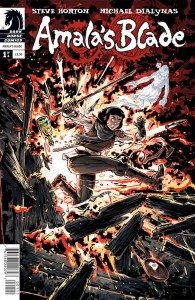 First up this week is Amala’s Blade #1. I made brief mention of the prequel issue #0 a few weeks back, and upon reread for this week I’ve found its charm growing on me. In her first full issue here, Amala has matured a great deal. The most sought after and skilled assassin in her realm, Alama’s skills are in as much demand as her head. Sadly, she feels her head isn’t on quite straight, tormented as she is by the ghosts of those she’d killed. Now, the masters who feel she’s grown to boisterous for their liking are sending her on a suicide mission. Being boisterous, though, is exactly what makes Amala such an appealing character, here and in her previous adventures in Dark Horse Presents. More than capable of holding her own in a fight, Amala is also teaching her friend Ren swordplay. (Although why she also falls into his arms and kisses him is beyond me, however.) It’s not so much surrendering her power over to her emotional engagement, but that it’s so ham-handed that it just seems out of place in the narrative. This book has considerably less charm than its #0 prequel, and we’ll have to wait and see if the ongoing series recovers.
First up this week is Amala’s Blade #1. I made brief mention of the prequel issue #0 a few weeks back, and upon reread for this week I’ve found its charm growing on me. In her first full issue here, Amala has matured a great deal. The most sought after and skilled assassin in her realm, Alama’s skills are in as much demand as her head. Sadly, she feels her head isn’t on quite straight, tormented as she is by the ghosts of those she’d killed. Now, the masters who feel she’s grown to boisterous for their liking are sending her on a suicide mission. Being boisterous, though, is exactly what makes Amala such an appealing character, here and in her previous adventures in Dark Horse Presents. More than capable of holding her own in a fight, Amala is also teaching her friend Ren swordplay. (Although why she also falls into his arms and kisses him is beyond me, however.) It’s not so much surrendering her power over to her emotional engagement, but that it’s so ham-handed that it just seems out of place in the narrative. This book has considerably less charm than its #0 prequel, and we’ll have to wait and see if the ongoing series recovers.
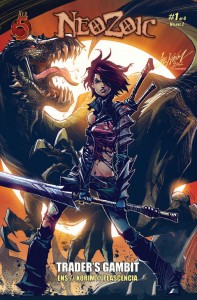 Alana’s fighting attire was practical and believable, and joining her this week with cool armor that that’s not just a metal bikini is Lilli Murko, the main character of Red 5 Comics’ NeoZoic: Trader’s Gambit #1. I was first introduced to this world of dinosaurs and men living side by side on Free Comic Book Day about 5 years ago, and it’s nice to see it still carrying on. Lilli is a member of the Predator Defense League, and her role in the recent war between humans and underground telepathic folk known as Telpids has left her as something of an outcast, reviled by some as a traitor and lauded by others as a hero. General Clawson, her mentor, has sent Lili away – along with a band of soldiers and a young Telpid girl who can communicate with dinosaurs – on a task to establish trade with the lands outside of the walled city of Monanti. Confused? I was just a bit, but not because of an overly complicated plot. This is a decent point to jump into the story, save for one flaw. Jae Korim’s art, with its flamboyant anime-inspired style, is lovely to look at. Unfortunately, each the women soldiers in this book aren’t portrayed with enough differentiation. For several panels, it seemed like Lilli was having a conversation with herself, before I realized it was actually two different characters. Don’t get me wrong, I love the premise of several tough ladies fighting dinosaurs (who wouldn’t?) but more could be done to develop each character as unique. In a well established world like NeoZoic, it might be easy to assume we all know who’s who, but if you’re going to mark your book #1, the story and art need to set us on the right path, and not just the beginning of a new act in a long play.
Alana’s fighting attire was practical and believable, and joining her this week with cool armor that that’s not just a metal bikini is Lilli Murko, the main character of Red 5 Comics’ NeoZoic: Trader’s Gambit #1. I was first introduced to this world of dinosaurs and men living side by side on Free Comic Book Day about 5 years ago, and it’s nice to see it still carrying on. Lilli is a member of the Predator Defense League, and her role in the recent war between humans and underground telepathic folk known as Telpids has left her as something of an outcast, reviled by some as a traitor and lauded by others as a hero. General Clawson, her mentor, has sent Lili away – along with a band of soldiers and a young Telpid girl who can communicate with dinosaurs – on a task to establish trade with the lands outside of the walled city of Monanti. Confused? I was just a bit, but not because of an overly complicated plot. This is a decent point to jump into the story, save for one flaw. Jae Korim’s art, with its flamboyant anime-inspired style, is lovely to look at. Unfortunately, each the women soldiers in this book aren’t portrayed with enough differentiation. For several panels, it seemed like Lilli was having a conversation with herself, before I realized it was actually two different characters. Don’t get me wrong, I love the premise of several tough ladies fighting dinosaurs (who wouldn’t?) but more could be done to develop each character as unique. In a well established world like NeoZoic, it might be easy to assume we all know who’s who, but if you’re going to mark your book #1, the story and art need to set us on the right path, and not just the beginning of a new act in a long play.
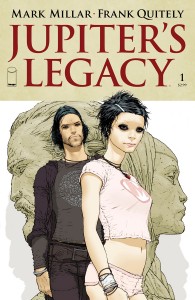 Jupiter’s Legacy #1 from superstar creators Mark Millar (Kick Ass, Wanted) and Frank Quitely (All-Star Superman, The Authority with Millar) is a weighty first issue, with the story centering on Chloe and Brandon Sampson, the adult children of their world’s first super heroes. Their parents discovered a mysterious island during the Great Depression, where they were granted great powers, and the responsibility to shepherd America through it’s toughest historical challenges. In the present, their children are super powered second generation celebrities, with all the horrible characteristics one might expect. Brandon is a lazy young man content to fondle groupies in nightclub bathrooms while complaining about his sister becoming a superhuman sell-out. Chloe, meanwhile, has embraced non-violence, veganism and drug use, while complaining about how tragically her parents just don’t understand her. Meanwhile, her dad The Utopian (an elderly Superman analogue) and her uncle Walter argue about how their role in the world has helped or hurt humanity, all while pummeling yet another super villain into unconsciousness. The argument isn’t to shed light on the nature of super heroes in American culture (as has been done so many times before, even by Millar, to a better effect) but to address how these types of heroes might view the world we live in now. There are no fictional political issues, and they speak openly of Obama, the European debt crisis, and austerity measures. The super hero genre is an unusual medium to address economic issues and that’s the part of the story that goes off the rails. However, the blunt portrayal of the children of heroes as burnt out celebrity brats was much more compelling, and both Chloe and Brandon, despite their super hearing or the ability to fly, are very real human characters who would be worth reading about further.
Jupiter’s Legacy #1 from superstar creators Mark Millar (Kick Ass, Wanted) and Frank Quitely (All-Star Superman, The Authority with Millar) is a weighty first issue, with the story centering on Chloe and Brandon Sampson, the adult children of their world’s first super heroes. Their parents discovered a mysterious island during the Great Depression, where they were granted great powers, and the responsibility to shepherd America through it’s toughest historical challenges. In the present, their children are super powered second generation celebrities, with all the horrible characteristics one might expect. Brandon is a lazy young man content to fondle groupies in nightclub bathrooms while complaining about his sister becoming a superhuman sell-out. Chloe, meanwhile, has embraced non-violence, veganism and drug use, while complaining about how tragically her parents just don’t understand her. Meanwhile, her dad The Utopian (an elderly Superman analogue) and her uncle Walter argue about how their role in the world has helped or hurt humanity, all while pummeling yet another super villain into unconsciousness. The argument isn’t to shed light on the nature of super heroes in American culture (as has been done so many times before, even by Millar, to a better effect) but to address how these types of heroes might view the world we live in now. There are no fictional political issues, and they speak openly of Obama, the European debt crisis, and austerity measures. The super hero genre is an unusual medium to address economic issues and that’s the part of the story that goes off the rails. However, the blunt portrayal of the children of heroes as burnt out celebrity brats was much more compelling, and both Chloe and Brandon, despite their super hearing or the ability to fly, are very real human characters who would be worth reading about further.
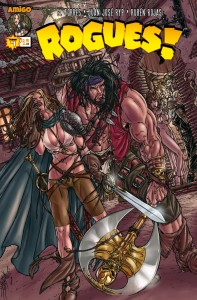 The same can’t be said for newcomer Amigo Comics’ Rogues #1. This Spanish, creator-owned company was founded to publish this very series in Europe, and its original artist Juan Jose Ryp actually began his work in erotica. This book, and those to follow it from Amigo, are marked “For Mature Readers”, and contain consistent nudity and adult situations, for certain. Not that this makes them in anyway reprehensible, as such stories and images have their place. Indeed, the titular Rouges are exactly that. They are a pair of thieves, an enormous ax-wielding brute named Bram, and his scantily clad female companion known only as the Weasel. It’s a silly book all around – the scoundrels break out a “virginal princess” from a tower of pleasure and are haunted by a plague of … chickens. It’s obviously sexualized under the guise of “adult” readership, and while the characters might toss around a funny quip or two, they are flat and unimaginative. And even given the adult nature of the comic, it’s still baffling how the Weasel is seemingly unable to engage in combat, or even to fall down, without thrusting her nearly naked rear end directly into the front of every other panel. While this might be someone’s titillating dream come true, it makes for horrible storytelling.
The same can’t be said for newcomer Amigo Comics’ Rogues #1. This Spanish, creator-owned company was founded to publish this very series in Europe, and its original artist Juan Jose Ryp actually began his work in erotica. This book, and those to follow it from Amigo, are marked “For Mature Readers”, and contain consistent nudity and adult situations, for certain. Not that this makes them in anyway reprehensible, as such stories and images have their place. Indeed, the titular Rouges are exactly that. They are a pair of thieves, an enormous ax-wielding brute named Bram, and his scantily clad female companion known only as the Weasel. It’s a silly book all around – the scoundrels break out a “virginal princess” from a tower of pleasure and are haunted by a plague of … chickens. It’s obviously sexualized under the guise of “adult” readership, and while the characters might toss around a funny quip or two, they are flat and unimaginative. And even given the adult nature of the comic, it’s still baffling how the Weasel is seemingly unable to engage in combat, or even to fall down, without thrusting her nearly naked rear end directly into the front of every other panel. While this might be someone’s titillating dream come true, it makes for horrible storytelling.
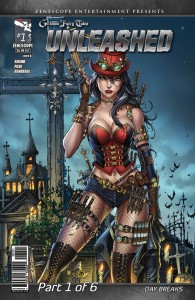 Lastly, the boys at Zenescope are at it again, unveiling new #1’s in what they are calling the largest Grimm Universe Event yet. We’ve talked about the characters from the Grimm Fairy Tales series here before, and branded Zenescope as some of the worst offenders when it comes to the over-sexualization of women in comics. Their ongoing collection of series about the likes of Cinderella, Alice in Wonderland, or a female Robin Hood have often been the most egregious when it comes to forgetting that in the real world, women don’t tend to routinely leave the house in just their underwear, much less engage in hand to hand combat in such clothing. The main series begins with Grimm Fairy Tales: Unleashed #1, and continues with the origin story of one villain, the Queen of Vampires in Grimm Fairy Tales: Vampires The Eternal #1, but neither do a good job of starting their stories from the beginning. They obfuscate the past (which we’d all be better off knowing in this case) and seem to simply exist to show us women with heaving bosoms, in various states of undress, kicking each other. Again, while there’s certainly nothing wrong with sexually empowered women protecting humanity from monsters, at the hands of Zenescope they’re rarely treated as anything more than sexual objects and don’t make for very convincing heroes.
Lastly, the boys at Zenescope are at it again, unveiling new #1’s in what they are calling the largest Grimm Universe Event yet. We’ve talked about the characters from the Grimm Fairy Tales series here before, and branded Zenescope as some of the worst offenders when it comes to the over-sexualization of women in comics. Their ongoing collection of series about the likes of Cinderella, Alice in Wonderland, or a female Robin Hood have often been the most egregious when it comes to forgetting that in the real world, women don’t tend to routinely leave the house in just their underwear, much less engage in hand to hand combat in such clothing. The main series begins with Grimm Fairy Tales: Unleashed #1, and continues with the origin story of one villain, the Queen of Vampires in Grimm Fairy Tales: Vampires The Eternal #1, but neither do a good job of starting their stories from the beginning. They obfuscate the past (which we’d all be better off knowing in this case) and seem to simply exist to show us women with heaving bosoms, in various states of undress, kicking each other. Again, while there’s certainly nothing wrong with sexually empowered women protecting humanity from monsters, at the hands of Zenescope they’re rarely treated as anything more than sexual objects and don’t make for very convincing heroes.

